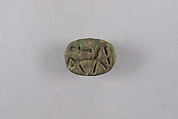Scarab with the Representation of a Horse
Third Intermediate Period
The horse was introduced in Egypt during the Second Intermediate Period (ca. 1640-1550 B.C.) and is frequently depicted in Egyptian art of the New Kingdom in scenes with chariots and horsemen or as the animal of the goddess Astarte. On seal-amulets of the Third Intermediate Period (ca. 1070-664 B.C.) the horse is often present as the main subject, accompanied by good-luck signs, such as the sign of life (ankh) or the hieroglyph for good and beautiful (nefer), or by royal titles. The latter association suggests that the horse is also one of the animals that symbolizes the (strength of the) pharaoh and, in extension, the sun god.
This image cannot be enlarged, viewed at full screen, or downloaded.
This artwork is meant to be viewed from right to left. Scroll left to view more.





